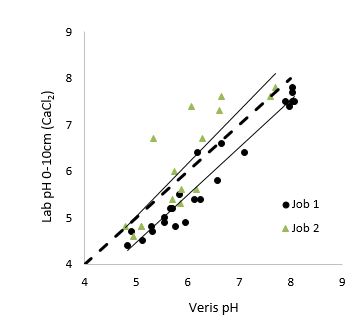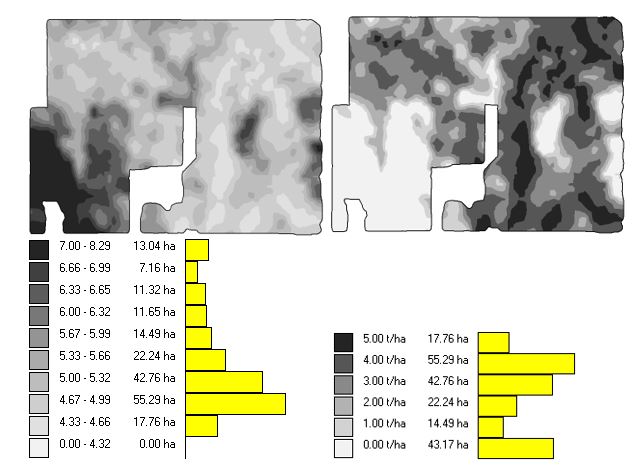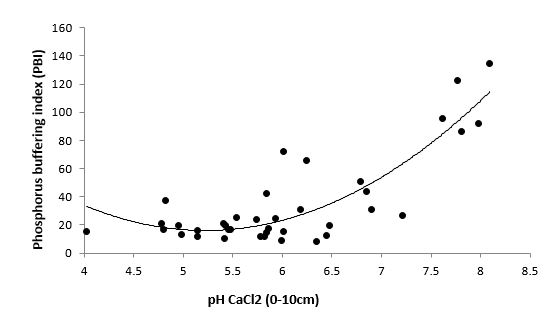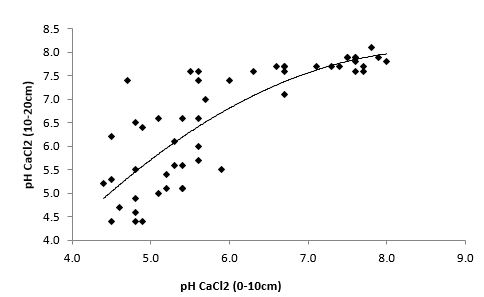pH mapping and variable rate lime application
Author: Trengove, S and Sherriff, S (Trengove Consulting) | Date: 12 Feb 2019
Take home messages
- Liming efficiency can be greatly improved through the use of pH mapping and variable rate technology.
- Veris® pH sensors (Antimony probes) have a good relationship with soil pH and can produce accurate maps for variable rate lime application.
Introduction
Mapping soil pH variability enables agronomy to be targeted more specifically, including the targeting of lime application only to where it is required on low pH soils. Systems for mapping soil pH fall into two main categories; grid-based sampling and the Veris® pH Manager that samples on-the-go. This paper refers to the use of the Veris® technology.
The Veris® pH Manager samples on-the-go taking on average, a sample every 15 seconds. At 10km/hr and 36m transects this equates to approximately seven samples/ha. Sampling depth is adjustable from 4cm-15cm, but typical operating depth is 6cm-10cm. The machine takes a soil sample on the go and then it presents it to two Antimony electrodes. Antimony is a metalloid that has a linear response to hydrogen ions in solution. Between samples two spray nozzles wash the electrodes with water.
While the relationship between the Antimony electrode and soil pH is linear, the relationship is not constant over a mapping season and can vary dependent on soil conditions and wearing of the electrodes. For this reason, each mapping job needs to be calibrated to soil pH CaCl2.Veris® pH is calibrated to a standard 0cm-10cm 1:5 CaCl2 value by identifying the range of pH measured by the Veris® and taking targeted soil samples from within 5m of the Veris® sample location, these are submitted for laboratory analysis. A different method of calibration is to take soil samples directly from the sample shoe during the mapping process and testing for pH 1:5 CaCl2. Simple linear regression is then used to assess the relationship between Veris® pH and pH CaCl2, and the equation of the line of best fit is used to convert Veris® pH to pH CaCl2 (Figure 1).
Figure 1. Linear regression between Veris® pH and laboratory pH (1:5 CaCl2) for two mapping jobs in the Mid North and Yorke Peninsula. Job 1: R2 = 0.94, y = 1.027x - 0.687. Job 2: R2 = 0.72, y = 1.139x - 0.674.
As for any lime rate calculation, to convert the soil pH map to a lime prescription requires information on target pH, soil texture factor (buffering factor) and lime quality. The example below (Figure 2) shows the conversion of a pH map to a lime prescription for a pH target of 6, a sandy soil (texture factor = 2) and lime with effective neutralising value of 65%, for a total application of 497t for the 192ha paddock. The lime comparison decision support tool developed by PIRSA will provide information on the most cost-effective source of lime to use.
In paddocks that have variability in soil texture, for example dune and swale landscapes, the accuracy of the lime prescription may be improved by adjusting the value of the soil texture value according to location in the rate calculation. Electrical conductivity (EC) or EM38 is generally quite responsive to soil texture and EC or EM38 maps can be used as a surrogate texture map to help refine the lime rate calculation further. Veris® Soil pH Manager (MSP) machines have the capability of mapping both soil pH and EC in one pass.
The map shown in Figure 2 indicates the total amount of lime required to reach the target pH. High application rates of lime can induce micronutrient deficiencies in some soil types. This needs to be considered when setting maximum application rates to be applied in a given cropping season.
Figure 2. L) Veris® soil pH calibrated to 0cm-10cm pH CaCl2, and R) resultant lime prescription map for pH CaCl2 target of 6, soil texture factor = 2 and effective neutralising value of lime = 65%.
Much of the focus for soil pH mapping has centred around identifying acidic soils for treatment with lime. However, there is more value in understanding soil pH variability than just lime. For example, soil pH is also known to influence nutrient availability, herbicide activity and herbicide residue persistence and microbial activity. Below is an example from a Yorke Peninsula farm of the relationship between soil pH and phosphorus buffering index (PBI), where PBI increases with increasing pH (Figure 3). In the case of variable rate phosphorus application, this information could be used to refine application rates in paddocks with variable soil pH, where rates can be increased in areas with high pH and/or decreased in areas with lower soil pH. The relationship between pH and PBI may be location specific and needs to be assessed case by case before adopting a similar strategy.
The Veris pH mapping technology is usually used at one depth across each paddock, typically 6-10cm, however soil acidity below this depth can occur. It is wise to take a number of soil cores within each paddock using depth intervals of 0-5, 5-10, 10-20, 20-30, >30cm to understand the pH profile. A soil pH map can be used to target specific sites where subsurface soil acidity could be a problem. Figure 4 shows data from the upper Yorke Peninsula and Narrung where surface pH has a relationship with subsurface soil pH. Areas with high surface pH (pH > 6) typically have high subsurface pH (10 – 20 cm). However, note the increase in scatter where surface pH is less than 6. The risk of sub surface soil acidity increases as surface pH decreases.
Figure 3. Relationship between pH CaCl2 and phosphorus buffering index for a Yorke Peninsula farm (y = 11.949x2 - 124.81x + 341.98, R² = 0.7356).
Figure 4. Relationship between 0 – 10cm and 10 – 20cm pH CaCl2 for data from Yorke Peninsula and Narrung (y = -0.17x2 + 3.01x - 4.99, R² = 0.668).
Conclusion
The work we have undertaken with clients has shown that liming efficiency can be greatly improved through the use of pH mapping and variable rate technology. Veris® pH sensors (Antimony probes) have been used to measure soil pH and have been shown to have a good relationship with soil pH, and therefore, produce accurate maps for variable rate lime application.
Contact details
Sam Trengove
samtrenny34@hotmail.com
Was this page helpful?
YOUR FEEDBACK




